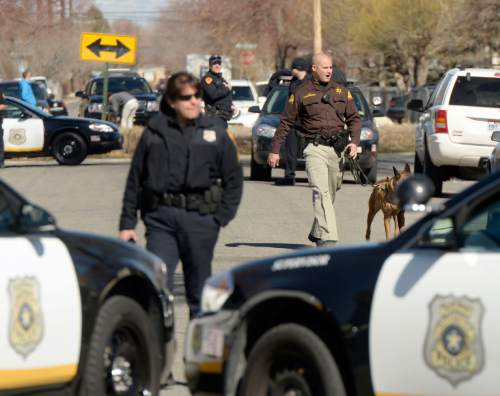This is an archived article that was published on sltrib.com in 2015, and information in the article may be outdated. It is provided only for personal research purposes and may not be reprinted.
Salt Lake City police officers are "working feverishly" to keep up with crime.
That's according to the police union's president, Michael Millard. As the population grows, crime has gone up almost every year in Salt Lake City since at least 2011, according to the police department's own statistics. But staffing at the department hasn't grown with the problem, Millard said. And as city budget negotiations begin this month, he's asking the city to hire 25 to 30 more officers to keep up.
"Our officers are working feverishly to keep up with the call volume," detectives have high caseloads and officers are often handling calls alone — when two officers may be better — to cut down on how long residents have to wait, Millard said in an open letter.
The letter was published to the union's website Thursday.
Millard pointed out that residents are seeing an increase in crime, so it feels like there are fewer officers in their neighborhoods. Specifically, east-siders feel unprotected as the police have shifted their patrols downtown in the past two years — particularly in the Pioneer Park area.
"There is a lot of concern at every community council meeting I attend," District 6 Councilman Charlie Luke, who represents Yalecrest and surrounding areas, said at a budget meeting last month.
Councilwomen Erin Mendenhall and Lisa Adams, who represent the East Liberty and Sugar House neighborhoods, respectively, also said that parts of their neighborhoods have suffered since the bike patrols left.
The police department's operational flexibility model allows officers to go where they are needed. And in the past few years, criminal activity has been heavily concentrated in the center of the city. Luke's District 6 sees about 1,200 to 1,400 crimes a year. The Sugar House neighborhoods see about 3,700 to 4,100 a year. District 4, which includes downtown, sees about 12,800 to 16,800.
"Currently, Salt Lake City is on track for a fifth straight year of overall increase in Part 1 crimes," Millard wrote. The category includes the more serious offenses, such as murder, rape, robbery and stealing a car. Citywide, that category has gone up every year since 2011. "Part 2" crimes, which are lesser offenses such as public intoxication and fraud, fluctuated until they wound up higher in 2014 than in 2011.
But at the budget meeting to discuss the east side, Burbank said crime has not gone up.
He also didn't embrace the notion of beefing up patrols as a fix-all. If police arrest a drunk in a park, he will be back the next day, the chief explained.
Police have busted the same people hundreds of times, Burbank said. Jailing alcoholics and drug addicts and other so-called undesirables is not working, he added.
"Alternatives to incarceration reduce [jail] recidivism," the chief said. "It's a balancing act. We need to work holistically."
The Salt Lake County jail feels that strain; the facility is constantly at capacity. Salt Lake County Sheriff Jim Winder isn't planning on jailing certain nonviolent offenders this summer — instead, they will be released under an expanded supervision program.
Besides alleviating the swollen jail in the short term, Winder believes the plan is a way to help reduce recidivism in the long term.
Salt Lake City's budget negotiations begin this month. Mayor Ralph Becker's proposed $254 million budget directs $60.4 million to the police department.
The request includes 12 new positions for the department. But five of them are current officers who have been funded through a federal grant that is coming to an end. The other seven are civilian personnel who will free up sworn officers for other duties.
If the city decides to add more police officers, Millard suggested not relying on a federal grant to do it. A denial of the grant, Millard wrote, "would result in a further delay to add officers to the street."
Twitter: @MikeyPanda



